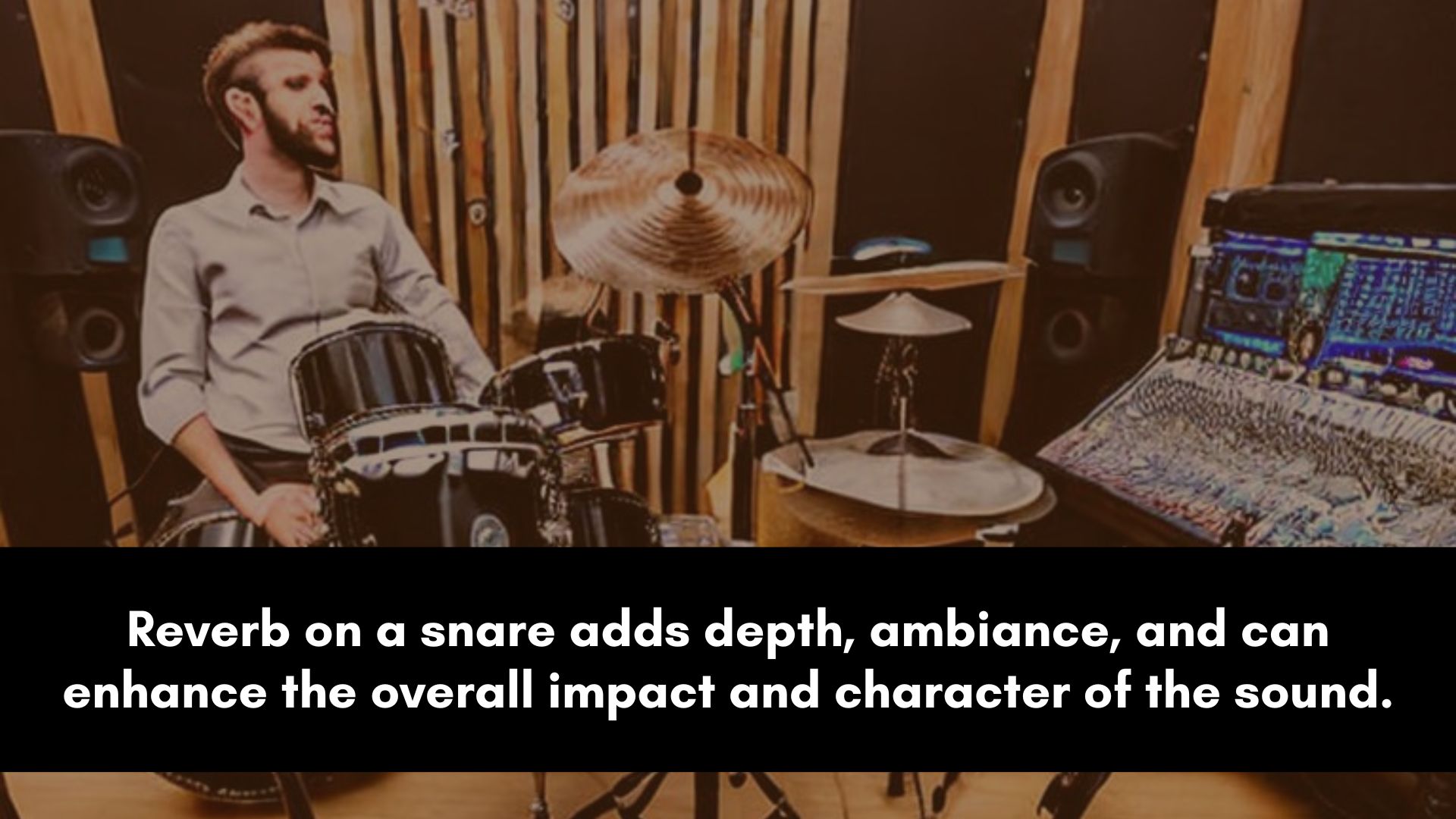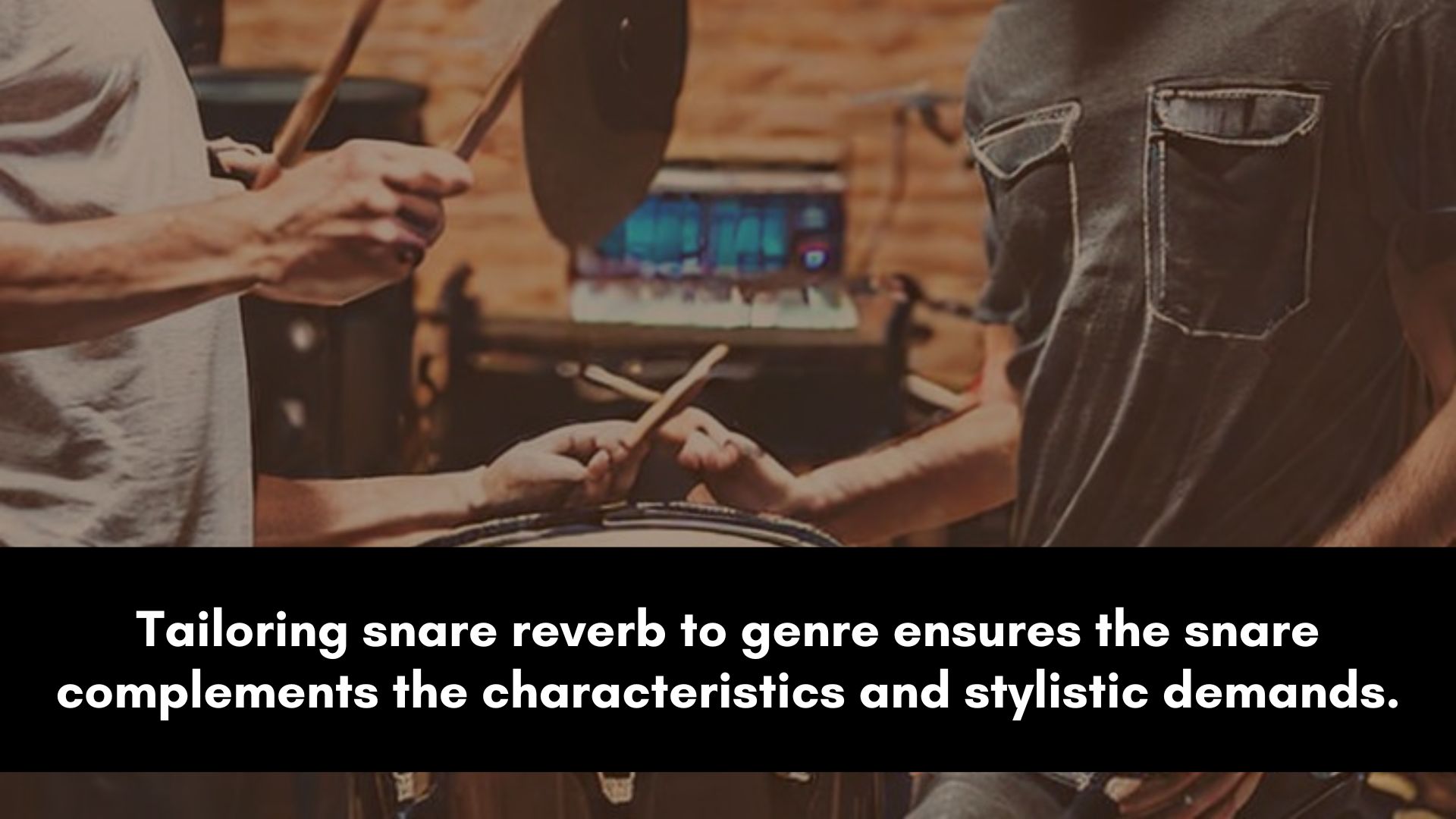Mixing drums is an art, and mastering reverb is the secret ingredient that can elevate your mixes from good to mind-blowing.
Imagine your snare drum taking on a three-dimensional quality, filling the sonic space with depth, impact, and sheer power.
In this blog post, we're about to embark on an exhilarating journey through the world of snare reverb.
We'll unravel powerful tips and tricks that will empower you to craft epic snare mixes that will leave a lasting impression on your audience.
Buckle up and get ready for a sonic adventure like no other.
Snare Reverb Settings: Step-by-step Guide

Mastering snare reverb is the key to unlocking the magic that transforms ordinary drums into epic sonic masterpieces.
Snare reverb is the sonic glue that adds dimension and character to drum mixes.
Without it, your drums may sound dry and lack excitement, leaving the mix feeling flat and lifeless.
Selecting the Appropriate Reverb Type
Different reverb types offer distinct sonic characteristics, and choosing the right one can make a significant difference in the snare drum sound.
Here are a few common reverb types to consider:
- Room Reverb: This type emulates the sound of a small to medium-sized room and is often used to create a sense of space and naturalness. It works well for snare drums in genres like jazz, acoustic, and singer-songwriter.
- Plate Reverb: Plate reverbs provide a more artificial and dense ambience, characterized by a smooth and rich decay. They can add a touch of vintage flavor to your snare sound and are commonly used in rock, pop, and ballad genres.
- Hall Reverb: Hall reverbs simulate the acoustics of large concert halls and cathedrals. They offer a long decay time and a more pronounced sense of spaciousness. Hall reverbs can work wonders for creating epic and cinematic snare sounds.
Experiment with different reverb types to find the one that best complements your snare drum and fits the desired musical style.
Remember, the choice of reverb is subjective, so trust your ears and personal taste.
Setting Up Snare Reverb
Now that you have chosen the right type of reverb for your snare, it's time to dive into setting up the reverb parameters to achieve any desired effect.
Follow these steps to get started:
Adjusting Reverb Parameters
- Decay Time: Increase the decay time for longer, more spacious reverbs, or decrease it for shorter, tighter reverbs. For snare drums, a moderate decay time is usually preferred to maintain clarity and punch.
- Predelay: Adjust the predelay to create separation between the dry snare hit and the onset of the reverb. A shorter predelay can make the snare sound more integrated with the reverb, while a longer predelay can add a sense of depth and spaciousness.
- High Pass Filter: Apply a high pass filter to the reverb to remove excessive low-frequency content that can muddy the mix. Snare drums typically benefit from a clean and focused reverb, so consider setting the high pass filter around 200 Hz or higher.
- Early Reflections: Some reverb plugins allow you to control the early reflections, which simulate the initial sound reflections in a room. Adjusting the early reflections can add realism and depth to the snare reverb.
Pre-Delay Tips
Pre-delay plays a crucial role in the perception of space and can greatly influence the snare reverb sound.
Try some of these pre-delay settings for different effects:
- Short Pre-Delay: Use a short pre-delay (around 10-30 milliseconds) for a tight and upfront snare reverb. This can help maintain the snare's attack while adding a subtle sense of depth.
- Medium Pre-Delay: Set a medium pre-delay (around 40-70 milliseconds) to create a natural sense of space. This setting allows the initial snare hit to be distinct while giving the reverb tail enough time to develop.
- Long Pre-Delay: Experiment with a longer pre-delay (above 100 milliseconds) for pronounced and spacious snare reverbs. This can be effective for creating ambient and atmospheric snare sounds, particularly in genres like electronic and experimental music.
Remember, every snare drum and mix is unique, so don't hesitate to tweak and experiment with the reverb parameters until you achieve the desired sound.
Settings For Different Genres

The choice and application of snare reverb can vary across different music genres.
Each genre has its own unique sonic characteristics and artistic goals.
Let's explore how reverb is used in various genres and the techniques associated with them:
A. Rock and Pop:
In rock and pop music, the snare drum often plays a central role in driving the rhythm and energy of the song.
Reverb is commonly used to add impact, depth, and sustain to the snare sound.
Here are some techniques to consider:
- Plate Reverb: Utilize plate reverbs to create a classic and dense snare reverb that enhances the power and impact. Experiment with longer decay times and moderate to high predelay settings for a rich and full-bodied snare sound.
- Gated Reverb: Apply gated reverb techniques to achieve a distinctive snare sound popular in '80s rock music. By placing a noise gate after the reverb, you can create a sharp and punchy snare with a quick decay while still preserving the desired reverb tail.
B. Jazz and Acoustic
In jazz and acoustic genres, a natural and transparent snare reverb is often preferred to maintain the authenticity and clarity of the instrument.
Consider the following techniques:
- Room Reverb: Opt for room reverbs to replicate the sound of a small to medium-sized live room. Set a moderate decay time to create a subtle sense of space without overwhelming the natural acoustic qualities of the snare drum.
- Short Predelay: Use a shorter predelay to maintain the tightness and articulation of the snare, ensuring the initial attack remains clear while adding a touch of ambience to the overall sound.
C. Electronic and Experimental
In electronic and experimental genres, reverb can be a creative tool to shape unique and otherworldly drum sounds.
Here are some techniques to explore:
- Long Decay Times: Embrace longer decay times to create expansive and atmospheric reverb sounds. This can contribute to the sense of space and otherworldliness in the music.
- Modulation and Filtering: Apply generous modulation and filtering to the snare reverb to introduce movement and texture. Experiment with automation or LFO-controlled modulation to create evolving and dynamic snare reverb effects.
D. Hip-Hop and R&B
In hip-hop and R&B, the snare reverb is often used to add depth and character to the drum sound.
Here are a few guidelines you can follow as a starting point:
- Room and Plate Reverbs: Blend room and plate reverbs to achieve a balanced and pleasing snare sound. Use shorter decay times to maintain the snappy and punchy nature of the genre while still adding a touch of space and dimension.
- Parallel Processing: Create parallel processing chains for the snare reverb, allowing you to blend the processed and dry signals to achieve the desired level of depth and impact.
Remember, these genre-specific techniques are not rigid rules but rather guidelines for experimentation.
Feel free to adapt and combine techniques to suit your artistic vision and the specific requirements of your music.
Adding Depth
To add depth and dimension to your snare drum sound, leveraging the power of reverb is essential.
Follow these techniques to create a captivating sense of space:
- Small Room: Select a smaller room size and a shorter decay time to create a tight and focused snare reverb. This technique works well in genres like rock and pop, where a punchy and upfront snare sound is desired.
- Medium Room: Opt for a medium-sized room with a moderate decay time for a balanced and natural snare reverb. This approach adds a sense of depth while maintaining clarity and definition. It is suitable for a wide range of musical styles.
- Large Room: Choose a larger room size and a longer decay time to achieve a spacious and ambient snare reverb. This technique works particularly well in genres that require a more expansive and atmospheric drum sound, such as electronic and cinematic music.
Achieving Natural Reverb Sound
To create a natural snare reverb sound that blends seamlessly with your mix, consider the following techniques and processing:
Applying equalization to the reverb tracks can help shape the signal and ensure it complements the overall mix.
- High-End Roll-off: Use a high-pass filter to roll off excessive low frequencies in the reverb tail. This prevents muddiness and keeps the sound clear and defined. Start with a gentle roll-off around 300 Hz and adjust to taste.
- Taming Harshness: Address any harsh or resonant frequencies with a narrow-band EQ cut. Sweep the frequency range while the snare reverb is soloed, and attenuate any unpleasant frequencies. This helps maintain a smooth and pleasing snare reverb sound.
- Enhancing Presence: Boosting the upper midrange frequencies in the reverb signal can add presence and clarity. Experiment with a gentle boost around 2-5 kHz to bring out the desired characteristics of the snare drum.
FAQ:
Should I put reverb on the snare?
Whether or not to put reverb on the snare depends on the desired sound and the context of the mix.
Reverb can add depth, ambiance, and a sense of space to the snare drum, enhancing its overall sound.
It can make the snare sound more spacious, epic, or fit better within a mix.
However, in certain genres or mixes that require a dry and upfront snare sound, minimal or no reverb might be preferred.
Ultimately, it's a creative decision, and you should trust your ears and consider the specific requirements of the song to determine whether adding reverb to the snare is beneficial.
Should snare reverb be mono or stereo?
Mono snare reverb can provide a more focused and centered sound, emphasizing the snare's punch and clarity.
On the other hand, stereo snare reverb can create a wider and more spacious sound, adding depth and dimension to the snare drum.
Experiment with both options and consider the genre, production style, and specific needs of your mix to determine whether mono or stereo snare reverb is more suitable.
